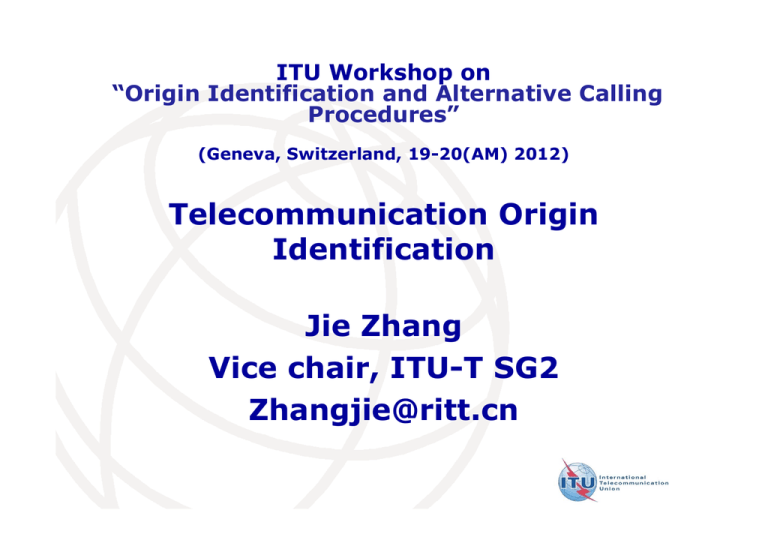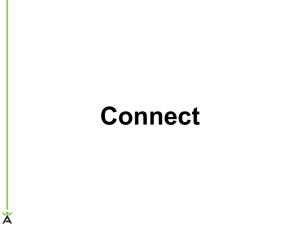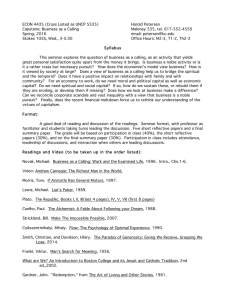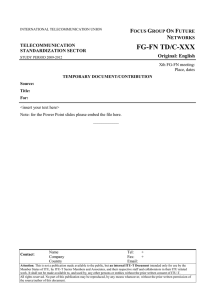Telecommunication Origin Identification Jie Zhang Vice chair, ITU-T SG2
advertisement

ITU Workshop on “Origin Identification and Alternative Calling Procedures” (Geneva, Switzerland, 19-20(AM) 2012) Telecommunication Origin Identification Jie Zhang Vice chair, ITU-T SG2 Zhangjie@ritt.cn Main content Overview of the topic Background What is telecommunication origin identification about? Overview of current practice in ITU-T What has been completed What is currently done what are the issues 2 Background The goal of this workshop present the current situation consider proposals for future work, if any. Report by the Chairman of Committee 5 PP10-Document 155 R1 Recommendation 6: The Plenipotentiary Conference instructs the Directors of TSB and BDT to collaborate in organizing one or more seminars or workshops on the topics covered by Resolutions 21 and 22, that is alternative calling procedures (including call-back and refile), telecommunication origin identification, and apportionment of revenues in providing international telecommunications services (including possible application of the concept of network externalities). 3 Concept Telecommunication ITU Constitution 1012 Telecommunication: Any transmission, emission or reception of signs, signals, writing, images and sounds or intelligence of any nature by wire, radio, optical or other electromagnetic systems. Origin ITU-T E.410(98) The location of the calling customer premises equipment. This may be specified to whatever accuracy is necessary. 4 Concept Identification Rec. ITU-R M.1224(1997) A step in a procedure used to identify a user or terminal to a service provider for the purposes of broad prevention. Rec. ITU-T X.1252 The process of recognizing an entity by contextual characteristics 5 Concept It’s hard to get precise definition for “Telecommunication Origin Identification (TOI)” from the existing definitions 6 Originating/transit/ terminating Network What? TOI Where? Circuit Switch/ IP based network Originator: Human beings/machines Who? Telecommuniation Identifiers: E.164, E.212, IPv4, IPv6, URI… 7 Telecommunication Identifiers --TD 65(WP1/2) Public telecommunication Fixed telephony service Mobile telephony service HTTP ‐service (web surfing) IP ‐based telephony service IM service E ‐mail service IPTV service Telex service … Fil transfer (FTP) Identifiers Telephone number (E.164) Telex number (F.69) ISPC/NSPC (Q.708) Data number (X.121) X.400 name (F.401) MNC (E.212) Domain name (RFC 1034) SIP URI (RFC 3261) CUG IC (Q.763) services (ID) E ‐mail address tel URI (RFC 3966) T(MNC) (ETS 300 392) IPv4 ‐address (RFC 791) IMEI (3GPP TS 23.003) PLMN 3G PLMN 3G (UMTS) (UMTS) TDM TDM IMT ‐2000 IMT ‐2000 B ‐ISDN B ‐ISDN (ATM) (ATM) IMS NGN NGN PSPDN/ PSPDN/ CSPDN CSPDN X.25/X.21 X.25/X.21 Web address (RFC 1738) Google Talk ID IPv6 ‐address (RFC 2460) NSAP (ISO 8348) IDs for end ‐ user services / applications IDs for network functions elements / IDs for adm. purpose ICC (M.1400) IDs for equipments MAC (ISO 8802.3) Public telecommunications PSTN/ISDN PSTN/ISDN TDM TDM (RFC 1521) TV URI (RFC 2838) IIN (E.118) Telecommunication Identifiers e networks PLMN 3G IMS PLMN 3G (UMTS/LTE) PS (UMTS/LTE) domain PS ‐2000 domain IMT IMT ‐2000 Broadcast Broadcast network network Internet Internet IPv4 IPv4 Internet Internet IPv6 IPv6 PLMN 4G PLMN 4G IMT ‐/LTE ‐ IMT ‐/LTE ‐ Advanced Advanced 8 Role of TOI Emergency services National security Counter terrorism The use of technology for social and community development Telecoms Anti-fraud Telecommunication Origin Identification Trust or not Trust Identifier of the originator is sent correctly by the originating career or service provider Identifier of the originator is transmitted transparently by transit/interconnecting careers or service provider except for the case where it is authorized to change it, e.g., change the NSN to the number with international format Telecommunication Industry 9 Current practice in ITU-T Focusing on E.164 numbers Not yet considering other identifiers WTSA-08 Resolution 65 Calling party number delivery (Johannesburg, 2008) E.157 (11/2009) International Calling Party Number Delivery ITR Whether and how to add new items 10 Types of CPN Service Number: Service access code Service subscriber number Subscriber Number: Fix, mobile, SIP, H.323, etc. Voice, video, messaging…… 11 Actions on CPN PABX, ISDN terminal (NT), SIP phone, Service Generate Verify Modify Transmit platform, LE, MSC, Softswitch, IP GW, Signaling board…… PABX, LE, TM, GW, Service platform, Softswitch, IP GW, SMSC,Signaling board…… Authorized: LE, TS, IS, SCP, Service platform ,Signaling board…… Unauthorized: Service platform, PABX, MG…… STP, SG…… 12 Invented CPN-1 1.Dial access code 2.Input Calling and Called number Fixed/Mobile Network 3. Modify CPN 4. Connect 13 Invented CPN-2 1.Dial access code 3. Call back the calling party 2.Input Calling and Called number 4. Connect the called party Fixed/Mobile Network Internet 14 C56-October 2007 Scammer Ex.PSTN Set: Phone number to display =”110” (1) A scammer calls to a service that sets Calling Party Numbers freely. boundary (2) After connection, the scanner requests to set a destination number (victim’s telephone number) and a false calling party number (ex. 110(police)) by using dials etc. operator network international transfer network international transfer network Domestic Mobile network Calling Party No.: 110 ?? A Service of setting Calling Party Number freely (3) The service calls the victim with a false calling party number. Called Party(victim) 15 CPND and CLIP cookies bread …… flour cake CLIP …… MCID CPND 16 RESOLUTION 65 Calling party number delivery (Johannesburg, 2008) there appears to be a trend to suppress the transmission across international boundaries of calling party identification, in particular the country code and the national destination code such practices have an unfavorable effect on security and economic issues 17 Resolves to … consistent with technical capabilities and national legal and regulatory frameworks resolves international calling party number delivery shall, be provided based on the relevant ITU-T Recommendations that the delivered calling party numbers shall, consistent with technical capabilities and national legal and regulatory frameworks, be prefixed with country codes to identify in which country the calls are originated before they are delivered from an originating country to a receiving country 18 Resolves to … that, in addition to the country code, the delivered calling party number shall, include the national destination code, or sufficient information to allow proper billing and accounting, for each call that the calling party number shall, be transmitted transparently by transit networks (including hubs) 19 Instructs to … the concerned study groups, in particular Study Group 2 to expedite work on Recommendations that would provide additional detail and guidance for the implementation of, at least, the principles listed above the Director of the Telecommunication Standardization Bureau to report on the progress achieved by the study groups in implementing this resolution, which is intended to improve security and minimize fraud, and minimize technical harm as called for by Article 42 of the Constitution 20 E.157(11/2009) International Calling Party Number Delivery provides guidance for international calling party number delivery which is technology neutral International calling party number delivery refers to calling party number delivery across boundaries of countries Calling party number delivery is the basis for identifying the originating parties of calls and providing number identification supplementary services such as CLIP, MCID, which are specified in [ITU-T I.251] (for service) and [ITU-T Q.731] (for signalling) series 21 Calling party number Terminating network Transit network Calling party number Country C Country A Country D Country B Calling party number Originating network Terminating network E.157(09)_F01 22 General Principle consistent with technical capabilities and national legal and regulatory frameworks be provided based on the relevant ITU-T Recommendations For geographic numbers The delivered CPN shall be prefixed with country codes identifying the originating country In addition, the delivered CPN shall include the national destination code, or sufficient information to allow proper billing and accounting, for each call The CPN shall be transmitted transparently to the destination (succeeding) country by the transit network(s) (including hubs) 23 Guidance calling party numbers sent across international boundaries shall, consistent with technical capabilities and national legal and regulatory frameworks, contain as a minimum the country code of the originating country in the following cases the CLIR supplementary service is applicable Restrictions in cases of national legal and regulatory frameworks 24 Guidance For subscriber numbers, the delivered CPN shall be Normal call: number allocated by the operator Call forwarding: not the original called number Number portability: number shall not be changed PABX, branch office, private network and group telephone system: pilot numbers For a call originated by a call centor or public service platform, the delivered CPN shall be the number allocated to the service by the administrator For any party who does not have a telephone number, the delivered CPN shall be the country code from the country that the call has originated and the number allocated to the service platform by the administrator 25 Relevant ITU-T Recommendations Q.731. x-series concerning stage 3 descriptions for number identification supplementary services using Signalling System No. 7; Q.731.7 Stage 3 description for number identification supplementary services using Signalling System No. 7: Malicious call identification (MCID); I.251.3 Number identification supplementary services: Calling Line Identification Presentation; I.251.4 Number identification supplementary services: Calling Line Identification Restriction; I.251.7 Number identification supplementary services: Malicious call identification; Q.764 Signalling System No. 7 – ISDN User Part signalling procedures; Q.1912.5 Interworking between Session Initiation Protocol (SIP) and Bearer Independent Call Control protocol or ISDN User Part, ITU-T E.164 The international public telecommunication numbering plan 26 ECC RECOMMENDATION (11)02 Calling Line Identification and Originating Identification Calling Line Identification (CLI) can be understood as a set of parameters within telecommunications networks that provide users with capabilities of sending, receiving and displaying telephone numbers. The concept of OI provides users with similar kind of capabilities as the CLI, but the OI extends the traditional calling line identification to new networks, such as NGNs with identifiers other than E.164 numbers. In this Recommendation the term CLI is used alone when E.164 number usage is anticipated, otherwise the term OI/CLI is used. It proposes measures to increase trust in the OI/CLI. Comparing with E.157, it provides more detailed requirements and extends the scope to other identifiers 27 ITR status There were proposals from some member states to add new text on international CPND to ITR which has a higher level of authority than ITU-T recommendations Proposals of adding new text on international calling party number delivery to ITR have been discussed in CWG WCIT12 meetings. There were no agreement on these proposals. And there was also opposition to adding new text to ITR on this topic. ITR 1.4 References to CCITT Recommendations and Instructions in these Regulations are not to be taken as giving to those Recommendations and Instructions the same legal status as the Regulations. 28 Proposals Pursuant to article 3.5 International calling party number delivery shall be provided taking into account/in accordance with relevant ITU-T Recommendations to the greatest extent practicable Member States in certain specific circumstances may provide for data privacy by authorizing the masking of information other than the country code and national destination code but that masked information shall be made available to duly authorized law enforcement agencies 3.5 Member States shall ensure that the legal and regulatory frameworks and instruments applicable in their territories shall mandate Administrations, Recognized Operating Agencies, and Operating Agencies which operate in their territory and provide international telecommunications services offered to the public to apply the ITU-T Resolutions and Recommendations relating to naming, numbering, addressing and identification 29 Proposals Members shall ensure, consistent with technical capabilities and national legal and regulatory frameworks, that telecommunication administrations and operators cooperate in the implementation and application of the following measures: – Administrations and operators originating calls must provide the prefix designating the calling country code, in conformity with the relevant ITU-T Recommendations. – Transit administrations and operators must cooperate in identifying and transmitting to termination administrations and operators the code identifying the calling line corresponding to the traffic they receive. – Members will be able to respect the privacy of the data of the calling user, provided those data involve neither the code of the country of origin nor the national destination code. 30 Q&A? Thanks! 31





